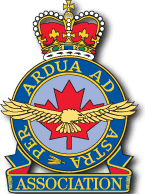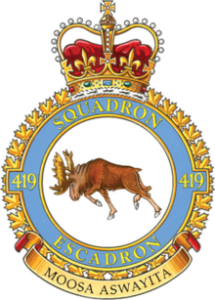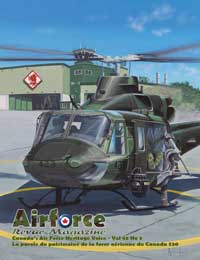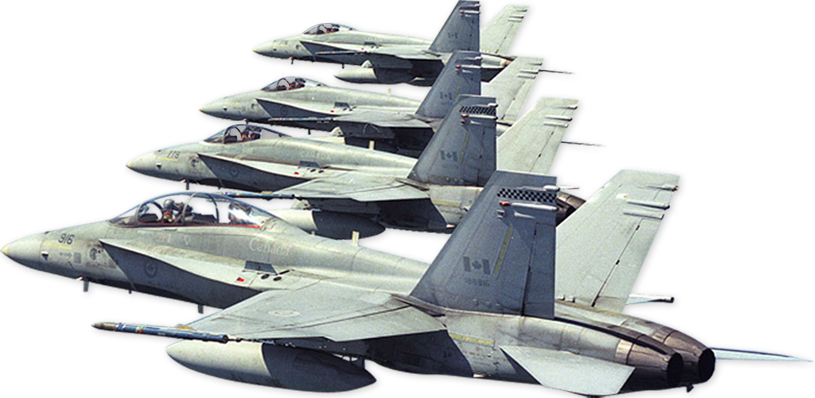 No. 419 Squadron
No. 419 Squadron
Badge: A moose attacking
Motto: Moosa aswayita (Beware of the moose)
Authority: King George VI, June 1944
The moose, representing the squadron’s nickname, is a fierce fighter indigenous to Canada. The motto is in Cree.
Formed at Mildenhall, Suffolk, England on 15 December 1941 as the RCAF’s 17th – third Bomber – squadron formed overseas, the unit flew Wellington, Halifax and Canadian-built Lancaster aircraft on strategic and tactical bombing operations. Among the many decorations awarded to its members was the Victoria Cross – posthumously, to P/O A.C. Mynarski. (1) After hostilities in Europe, the squadron was selected as part of “Tiger Force” for duty in the Pacific, and returned to Canada for reorganization and training. The sudden end of the war in the Far East resulted in the squadron being disbanded at Yarmouth, Nova Scotia on 5 September 1945.
Brief Chronology: Formed at Mildenhall, Suffolk, Eng. 15 Dec 41. Disbanded at Yarmouth, N.S. 5 Sep 45.
Title or Nickname: “Moose” (2)
Adoption: City of Kamloops, B.C.
Commanders
- W/C J. Fulton (Can/RAF), DSO, DFC, AFC 21 Dec 41 – 28 Jul 42 KIA.
- W/C A.P. Walsh (Can/RAF), DFC, AFC 5 Aug 42 – 2 Sep 42 KIA.
- W/C M.M. Fleming (Can/RAF), DSO, DFC 8 Sep 42 – 8 Oct 43.
- W/C G.A. McMurdy 11 Oct 43 – 22 Oct 43 KIA.
- W/C W.P. Pleasance, DFC and Bar 25 Oct 43 – 21 Aug 44.
- W/C D.C. Hagerman, DFC and Bar 22 Aug 44 – 25 Jan 45.
- W/C M.E. Ferguson 26 Jan 45 – 6 Aug 45.
- W/C H.R.F. Dyer, DFC 7 Aug 45 – 5 Sep 45.
Higher Formations and Squadron Locations
Bomber Command:
No. 3 Group,
- Mildenhall, Suffolk 21 Dec 41 – 12 Aug 42.
No. 4 Group,
- Leeming, Yorks. 13 Aug 42 – 17 Aug 42.
- Topcliffe, Yorks. 18 Aug 42 – 30 Sep 42.
- Croft, Yorks. 1 Oct 42 – 9 Nov 42.
- Middleton St. George, Durham. 10 Nov 42 – 31 Dec 42.
No. 6 (RCAF) Group,
No. 64 (RCAF) Base,
- Middleton St. George, Durham. 1 Jan 43 – 31 May 45.
- En route to Canada 1 Jun 45 – 4 Jun 45.
RAF “Tiger Force” (for ops), RCAF Eastern Air Command (for training):
No. 6 (RCAF) Group,
No. 661 (RCAF) Wing,
- Yarmouth, N.S. 5 Jun 45 – 5 Sep 45.
Representative Aircraft (Unit Code VR)
Vickers Wellington Mk.IC (Jan – Nov 42)
- Z1053 F Z1067 C Z1077 P Z1083 0 Z1091 A Z1095 Q Z1146 E Z8967 E Z8981 H Z9757 N Z9894 G Z9920 D DV509 S
Vickers Wellington Mk.III (Feb – Nov 42)
- X3277 F X3357 T X3416 J X3467 N X3470 E X3483 S X3484 0 X3486 U X3488 H X3563 T X3592 E X3659 B X3699 V X3711 R X3712 D X3715 G X3717 C X3796 C Z1572 Q Z1623 V Z1626 G BJ602 J BJ604 A BJ668 X
Handley Page Halifax B.Mk.II (Nov 42 – Apr 44)
- JB900 E JB929 J JDll 4 0 JD158 D JD163 N JD325 X JD410 V JD420 T JD456 B JD457 F JD458 C JD459 Q JP112 R }P121 S JP125 L JP200 G JP201 P JP202 T JP203 M JP204 E LW239 R LW243 Y LW325 H LW327 A
Avro Lancaster B.Mk.X (Mar 44 – Sep 45)
- KB700 Z KB704 Y KB707 W KB717 E KB718 J KB720 P KB712 BIE KB722 A KB731 S KB733 G KB738 D KB748 0 KB761 H KB767 U KB722 R KB776 F KB800 C KB814 N KB845 L KB854 T KB866 M KB869 Q KB878 I KB884 K
Operational History: First Mission 11 January 1942, 2 Wellington IC’ s from Mildenhall bombed Brest, France; W/C Foulton and crew in X9748 VR-B, P/O Cottier and crew in Z1145 VR-A.
Last Mission: 25 April 1945, 15 Lancaster X’s from Middleton St. George bombed gun positions on the Island of Wangerooge.
Summary Sorties: 4002.
- Operational/Non-operational Flying Hours: 25,386/8613.
- Bombs dropped: 13,417 tons.
- Victories: Aircraft: 10 destroyed, 6 damged.
- Casualties:
- Operational: 129 aircraft; 1404 aircrew, of whom 310 were killed, 867 missing, 187 POW, 40 evaded capture.
- Non-operational: 2 aircraft; 15 personnel, of whom 10 killed, 3 injured, 2 died.
Honours and Awards: I VC, 4 DSO’s, 1 MC, 3 bars to DFC, 150 DFC’s, 1 CGM, 35 DFM’s.
Battle Honours:
- English Channel and North Sea 1942-1944.
- Baltic 1942-1944.
- Fortress Europe 1942-1944.
- France and Germany 1944-1945: Biscay Ports 1942-1944, Ruhr 1942-1945, Berlin 1943-1944, German Ports 1942-1945, Normandy 1944, Rhine. Biscay 1942; 1944.
(1) 0n 12 June 1944, during a raid on Cambrai, France, Lancaster B.Mk.X KB726 VR-A, of which Mynarski was the mid-upper gunner, was set aflame by a German night fighter. The captain ordered the crew to abandon the aircraft, but the rear gunner was trapped and Mynarski made every effort to free him, but was unsuccessful. The rear gunner finally persuaded him to bail out and, although still trapped in his turret, survived the crash and became a prisoner of war. Mynarski died in a German hospital of severe burns. After the war, when details of his efforts to free the rear gunner became known, he was posthumously awarded the VC.
(2) Derived from the nickname of the squadron’s first commander, W/C John “Moose” Fulton, of Kamloops, B.C.









